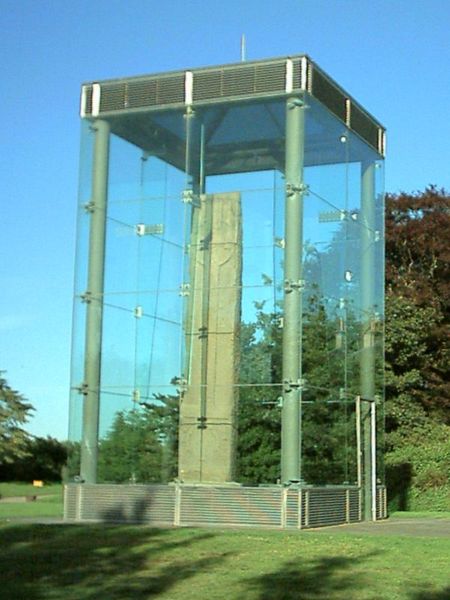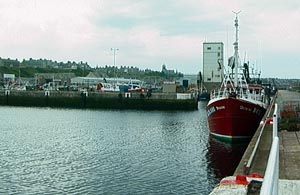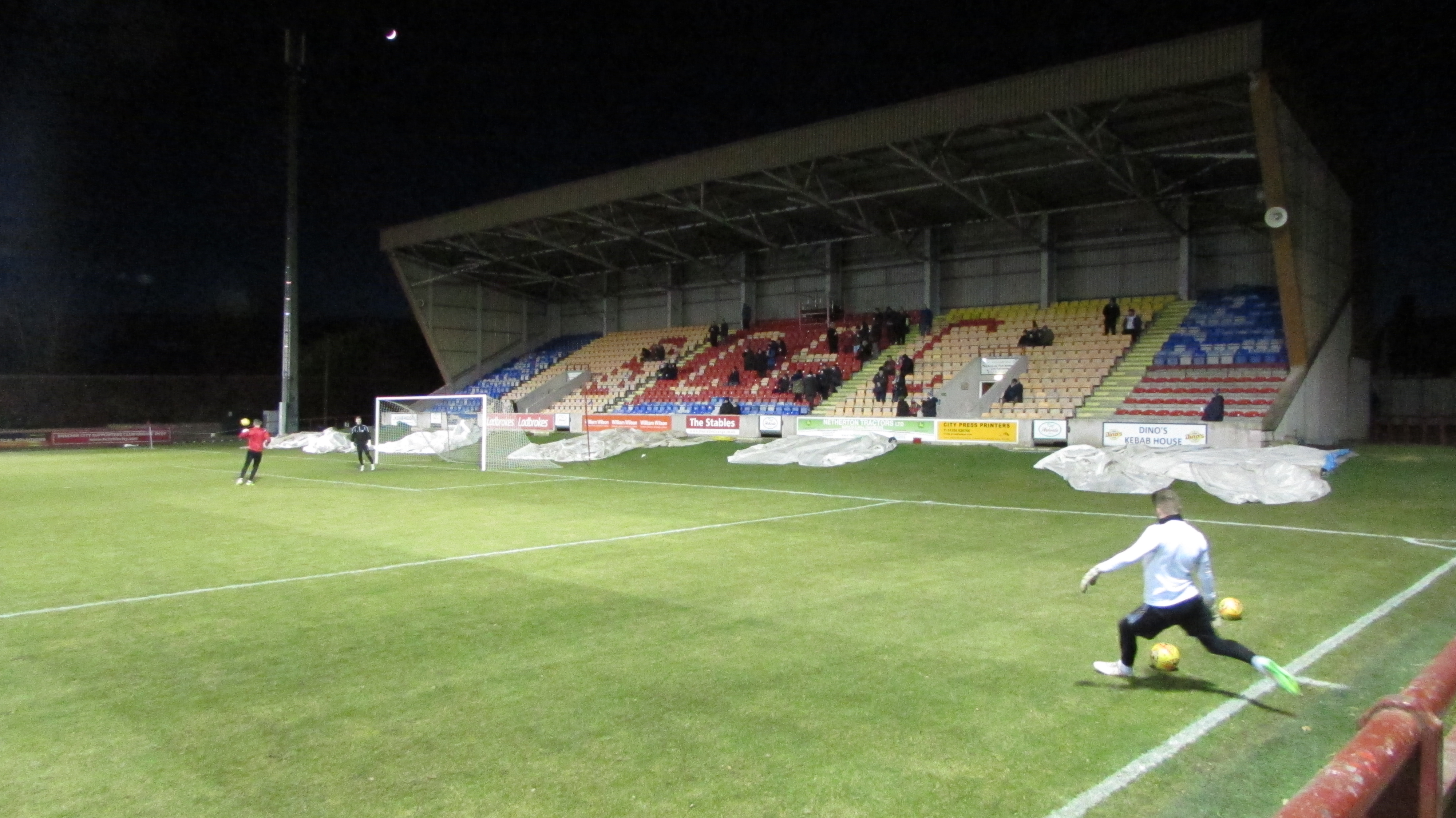|
2023–24 Highland Football League
The 2023–24 Highland Football League (known as the Breedon Highland League for sponsorship reasons) was the 121st season of the Highland Football League, and the 10th season as part of the fifth tier of the Scottish football pyramid system. Brechin City were the reigning champions, and were one of three teams that could have won the title in the final round of games, along with Buckie Thistle and Fraserburgh. Buckie Thistle's 1–0 win – a sixth consecutive win to finish the season – over Keith gave them their 12th Highland League title on goal difference from Brechin City, with Fraserburgh three points behind in third, having won their last ten games. However, Buckie Thistle were not eligible for the pyramid play-off as they did not hold a bronze-level club licence. Teams Stadia and locations All grounds are equipped with floodlights as required by league regulations. League table Results Highland League play-off Subject to the tier 6 champion clubs meeting the requ ... [...More Info...] [...Related Items...] OR: [Wikipedia] [Google] [Baidu] |
Highland Football League
The Scottish Highland Football League (SHFL, commonly known as the Highland League) is a senior football league based in the north of Scotland. The league sits at level 5 on the Scottish football league system The Scottish football league system is a series of generally connected leagues for Scottish football clubs. The Scottish system is more complicated than many other national league systems, consisting of several completely separate systems or 'gr ..., acting as a feeder to the Scottish Professional Football League. Founded in 1893, it is currently composed of 18 member clubs in a single division. Geographically, the league covers the Scottish Highlands as well as Moray, Aberdeenshire (unitary), Aberdeenshire, the cities of Aberdeen and Dundee, Angus (council area), Angus and parts of northern Perthshire. Since 2014–15, it has featured in the senior Scottish football league system, pyramid system. The winners take part in an end of season promotion play-off with the L ... [...More Info...] [...Related Items...] OR: [Wikipedia] [Google] [Baidu] |
Forres Mechanics F
Forres (; gd, Farrais) is a town and former royal burgh in the north of Scotland on the Moray coast, approximately northeast of Inverness and west of Elgin. Forres has been a winner of the Scotland in Bloom award on several occasions. There are many geographical and historical attractions nearby such as the River Findhorn, and there are also classical, historical artifacts and monuments within the town itself, such as Forres Tolbooth and Nelson's Tower. Brodie Castle, the home of the Brodie Clan, lies to the west of the town, close to the A96. A list of suburbs in the town of Forres contains: Brodie, Dalvey, Mundole and Springdale. Pre-history and archaeology Between 2002 and 2013 some 70 hectares of land was investigated by archaeologists in advance of a proposed residential development on the southern fringes of the town. They found an extensive Iron Age settlement and evidence that people lived in the area from the Neolithic ( radiocarbon dates from the 4th to the mid- ... [...More Info...] [...Related Items...] OR: [Wikipedia] [Google] [Baidu] |
Victoria Park, Buckie
Victoria Park is a association football, football ground in Buckie in north-east Scotland, which is the home ground of Highland Football League side Buckie Thistle F.C., Buckie Thistle. It is located at the junction of Midmar Street and South Pringle Street, from the town centre. The ground has a capacity of 5,000 with 400 seated,Buckie Thistle F.C. Highland Football League, The Scottish Highland Football League. Retrieved 21 May 2012. and is currently the largest in the league. History Buckie Thistle moved to Victoria Park in 1919 with the first opponents at the ground being Aberdeen F.C., Aberdeen.Buckie Thistle – C ...[...More Info...] [...Related Items...] OR: [Wikipedia] [Google] [Baidu] |
Buckie
Buckie ( gd, Bucaidh) is a burgh town (defined as such in 1888) on the Moray Firth coast of Scotland. Historically in Banffshire, Buckie was the largest town in the county until the administrative area was abolished in 1975. The town is the third largest in the Moray council area after Elgin and Forres and within the definitions of statistics published by the General Register Office for Scotland was ranked at number 75 in the list of population estimates for settlements in Scotland mid-year 2006. Buckie is virtually equidistant to Banff to the east and Elgin to the west, with both approximately distant whilst Keith lies to the south by road. Etymology The origin of the name of the town is not entirely clear. Although the folk etymology is that Buckie is named after a seashell (genus ''buccinum'') the reality is that the shared marine background is a coincidence. The name Buckie would not have originally identified a place immediately adjacent to the sea, so alternative ... [...More Info...] [...Related Items...] OR: [Wikipedia] [Google] [Baidu] |
Brora
Brora ( , gd, Brùra) is a village in the east of Sutherland, in the Highland area of Scotland. Origin of the name The name ''Brora'' is derived from Old Norse and means "river with a bridge". History Brora is a small industrial village, having at one time a coal pit, boat building, salt pans, fish curing, lemonade factory, the new Clynelish Distillery (as well as the old Clynelish distillery which is now called the Brora distillery ), wool mill, bricks and a stone quarry. The white sandstone in the Clynelish quarry belongs to the Brora Formation, of the Callovian and Oxfordian stages (formerly Middle Oolite) of the Mid-Late Jurassic. Stone from the quarry was used in the construction of London Bridge, Liverpool Cathedral and Dunrobin Castle. When in operation, the coalmine was the most northerly coalmine in the UK. Brora was the first place in the north of Scotland to have electricity thanks to its wool industry. This distinction gave rise to the local nickname of "Electr ... [...More Info...] [...Related Items...] OR: [Wikipedia] [Google] [Baidu] |
Glebe Park, Brechin
Glebe Park is a football stadium in Brechin, Scotland, which is the home ground of Brechin City. Glebe Park opened in 1919. The ground had just one portable stand, which had been used at the Perth agricultural show. Brechin City joined the Scottish Football League in 1929, when a pavilion was added and the Cemetery End terrace was covered. The biggest ever attendance was 8,123, against Aberdeen in a Scottish Cup tie played on 3 February 1973. This attendance was greater than the population of Brechin. Floodlights were installed and used for the first time in 1977, in a match against Hibernian. The old stand was replaced by a new Main Stand, with 290 seats, in 1981. Sponsorship by the Stewart Milne group and a Football Trust grant of £210,000 financed the construction of a 1,228 seat stand at the Trinity Road end of the ground. This stand had double the capacity of Brechin City's average attendance, which attracted criticism from non-league clubs in England, who believed tha ... [...More Info...] [...Related Items...] OR: [Wikipedia] [Google] [Baidu] |
Brechin
Brechin (; gd, Breichin) is a city and former Royal burgh in Angus, Scotland. Traditionally Brechin was described as a city because of its cathedral and its status as the seat of a pre-Reformation Roman Catholic diocese (which continues today as an episcopal seat of the Scottish Episcopal Church), but that status has not been officially recognised in the modern era. Nevertheless, the designation is often used, with examples being the City of Brechin and District Community Council, City of Brechin and Area Partnership, City of Brechin Civic Trust and Brechin City Football Club. Kinnaird Castle is nearby. Brechin is located slightly closer to Dundee than Aberdeen and is located on the A90 between the cities. It is the fourth largest settlement of Angus. History In the centre of Brechin is a small museum in the Brechin Town House, and an award-winning tourist attraction, the Caledonian Railway. Along with the cathedral and round tower, part of the chapel of Brechin's ''Mais ... [...More Info...] [...Related Items...] OR: [Wikipedia] [Google] [Baidu] |
Aberdeen
Aberdeen (; sco, Aiberdeen ; gd, Obar Dheathain ; la, Aberdonia) is a city in North East Scotland, and is the third most populous city in the country. Aberdeen is one of Scotland's 32 local government council areas (as Aberdeen City), and has a population estimate of for the city of Aberdeen, and for the local council area making it the United Kingdom's 39th most populous built-up area. The city is northeast of Edinburgh and north of London, and is the northernmost major city in the United Kingdom. Aberdeen has a long, sandy coastline and features an oceanic climate, with cool summers and mild, rainy winters. During the mid-18th to mid-20th centuries, Aberdeen's buildings incorporated locally quarried grey granite, which may sparkle like silver because of its high mica content. Since the discovery of North Sea oil in 1969, Aberdeen has been known as the offshore oil capital of Europe. Based upon the discovery of prehistoric villages around the mouths of the rivers ... [...More Info...] [...Related Items...] OR: [Wikipedia] [Google] [Baidu] |
Wick Academy F
Wick most often refers to: * Capillary action ("wicking") ** Candle wick, the cord used in a candle or oil lamp ** Solder wick, a copper-braided wire used to desolder electronic contacts Wick or WICK may also refer to: Places and placenames * -wick (-wich) town, settlements in Anglo-Saxon England * ''vicus'', the Latin word from which the Anglo-Saxon ''-wick'', ''-wich'', ''wic'' and ''-wych'' found within placenames derive. * -wick, from Old Norse ''vik'', bay or inlet, as in Wick, Caithness, and Lerwick Scotland * Wick, Caithness ** Wick Airport ** Wick (Parliament of Scotland constituency) (to 1707) England * Wick, Bournemouth, Dorset * Wick, Devizes, Wiltshire * Wick, Downton, Wiltshire * Wick, Gloucestershire * Wick, West Sussex * Wick, Worcestershire * Wick St. Lawrence, Somerset * Hackney Wick, London * Hampton Wick, London * Wick (ward), an electoral ward of the Hackney London Borough Council Wales * Wick, Vale of Glamorgan United States * Wick, Ohio * Wick, W ... [...More Info...] [...Related Items...] OR: [Wikipedia] [Google] [Baidu] |
Turriff United F
Turriff () is a town and civil parish in Aberdeenshire in Scotland. It lies on the River Deveron, about above sea level, and has a population of 5,708. In everyday speech it is often referred to by its Scots name ''Turra'', which is derived from the Scottish Gaelic pronunciation. Services and amenities There are four churches in Turriff: St Ninian's (Church of Scotland, 1794), St Andrew's (Church of Scotland), St Congan's (Episcopal Church, 1862), and a Baptist church. Turriff has a primary school, Turriff Primary School, and a secondary school, Turriff Academy. Turriff Primary School is a new build which replaced the old Markethill Primary School and opened to pupils on 22 August 2017. People from the surrounding areas, including the villages of Cuminestown, Fyvie and King Edward, attend the secondary school. Bank of Scotland, Santander UK (formerly Alliance & Leicester), Clydesdale Bank and TSB have branches in the town. The main supermarket chains are Tesco (whose premi ... [...More Info...] [...Related Items...] OR: [Wikipedia] [Google] [Baidu] |
Rothes F
Rothes (; gd, Ràthais) is a town in Moray, Scotland, on the banks of the River Spey, south of Elgin. The town had a population of 1,252 at the 2011 Census. A settlement has been here since AD 600. History and castle At the south end of the village lie the remains of Rothes Castle built on a hill by Peter de Pollok about 1200 to command traffic up and down this stretch of Strathspey. The castle's remains consist of a fragment of the massive outer wall overlooking the High Street of Rothes town. The castle was four storeys high, with a portcullis guarding the entrance to the inner courtyard and a drawbridge that crossed the dry moat, which ran between the outer wall and the hill on which the castle stood. Sir Norman Leslie, the castle's owner, was host to King Edward I of England on 29 July 1296. In the 1390s Rothes Castle and its lands were passed to the Leslie family, who would later become the Earls of Rothes. Some of the earliest houses in Rothes were built from stones o ... [...More Info...] [...Related Items...] OR: [Wikipedia] [Google] [Baidu] |
Nairn County F
Nairn (; gd, Inbhir Narann) is a town and royal burgh in the Highland council area of Scotland. It is an ancient fishing port and market town around east of Inverness, at the point where the River Nairn enters the Moray Firth. It is the traditional county town of Nairnshire. At the 2011 census, Nairn had a population of 9,773, making it the third-largest settlement in the Highland council area, behind Inverness and Fort William. Nairn is best known as a seaside resort, with two golf courses, award-winning beaches, a community centre and arts venue, a small theatre (called The Little Theatre) and one small museum, providing information on the local area and incorporating the collection of the former Fishertown museum. History The History of Nairn is a broad and diverse topic spanning its Palaeolithic and Mesolithic roots before recorded history, to the Picts and the visitation of Roman general Agriocola. Its possible founding under the name Ekkailsbakki by Sigurd, Earl ... [...More Info...] [...Related Items...] OR: [Wikipedia] [Google] [Baidu] |




.jpg)



